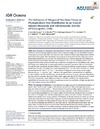Please use this identifier to cite or link to this item:
https://accedacris.ulpgc.es/jspui/handle/10553/73657
| Title: | The Influence of Diapycnal Nutrient Fluxes on Phytoplankton Size Distribution in an Area of Intense Mesoscale and Submesoscale Activity off Concepción, Chile | Authors: | Corredor-Acosta, A. Morales, C. E. Rodríguez-Santana, A. Anabalón, V. Valencia, L. P. Hormazabal, S. |
UNESCO Clasification: | 2510 Oceanografía | Keywords: | Coastal Upwelling Front Diapycnal Nutrient Flux Intrathermocline Eddy Phytoplankton Size Structure Thorpe Scale Method, et al |
Issue Date: | 2020 | Journal: | Journal of geophysical research. Oceans | Abstract: | Mesoscale and submesoscale processes that contribute to localized increases in nutrients in the sunlit layer can stimulate phytoplankton growth and community changes, but the mechanisms involved remain sparsely documented with in situ data in the case of Eastern Boundary Upwelling Systems (EBUSs) and of most ocean regions. The role of diapycnal mixing in providing nutrients to the upper layer and in influencing phytoplankton size structure was analyzed in an area of intense mesoscale and submesoscale activity during the coastal upwelling season off Concepción (~36–37°S), the Humboldt Current EBUS. Diapycnal nutrient fluxes based on conductivity, temperature, and depth vertical eddy diffusivity (Kz) values (the Thorpe scale method) and on nutrient gradients were assessed in association with size-fractionated chlorophyll-a and microdiatom abundance derived from in situ sampling in an area including a mesoscale intrathermocline eddy (ITE) adjacent to a coastal upwelling front (CUF). The indirect estimates of Kz values spanned between 0.01 and 4 × 10−4 m2 s−1, and maxima in diapycnal nitrate flux per station ranged between 0.08 and 19.1 mmol m−2 day−1. Maxima in the upward fluxes were detected at the subsurface (15–40 m depth) in the CUF and ITE areas, coinciding with maxima in the micro- and nano-chlorophyll-a fractions and in microdiatom abundance. These results suggest that ITE and CUF features, as well as their interaction, can generate intense diapycnal mixing and, thereby, contribute to increasing nutrient availability below the mixed layer. In turn, these processes enhance the contribution of larger phytoplankton cells in the coastal transition zone of EBUSs. | URI: | https://accedacris.ulpgc.es/handle/10553/73657 | ISSN: | 2169-9275 | DOI: | 10.1029/2019JC015539 | Source: | Journal of Geophysical Research: Oceans [ISSN 2169-9275], v. 125 (5), e2019JC015539 (Mayo 2020) |
| Appears in Collections: | Artículos |
SCOPUSTM
Citations
6
checked on Jun 8, 2025
WEB OF SCIENCETM
Citations
7
checked on Jun 8, 2025
Page view(s)
170
checked on May 31, 2025
Download(s)
215
checked on May 31, 2025
Google ScholarTM
Check
Altmetric
Share
Export metadata
Items in accedaCRIS are protected by copyright, with all rights reserved, unless otherwise indicated.
